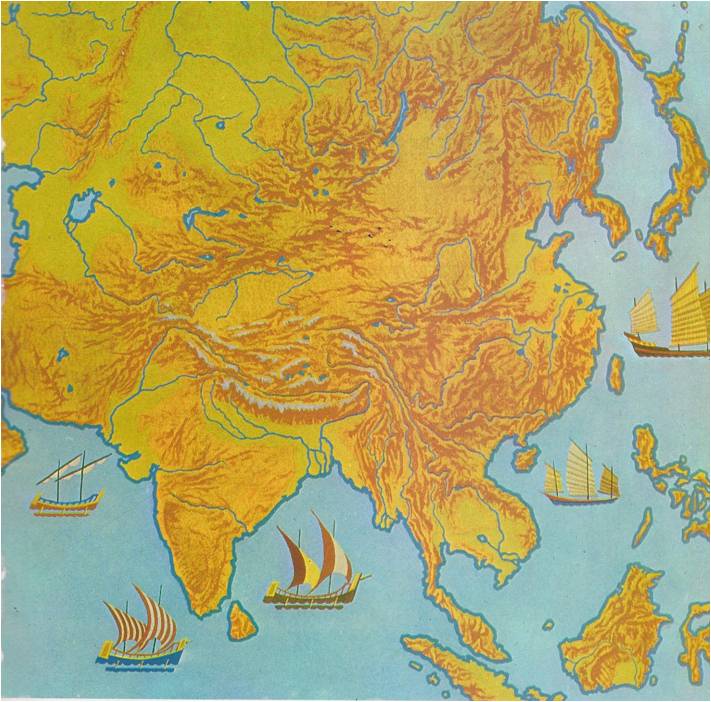WHEN Akbar died, the hope of a peaceful, prosperous India died with him. None of his successors was nearly so wise, open-minded, and farsighted. Even so, the Mogul Empire kept growing. The seventeenth century was, indeed, the height of Mogul power. Akbar’s son Jahangir reigned from 1605 to 1627. His name, which meant “grasper of the world,” did not fit him at all well, for he added only a little territory to the empire. Although he was clever and well-educated, Jahangir was also lazy and pleasure-loving. He was content to leave affairs of state to his Persian wife and her relatives. As he admitted in his memoirs, he “only wanted a bottle of wine and a piece of meat to make merry.” On Jahangir’s death, his two sons began to fight over which should succeed him. Before the question was settled, the winner had killed his brother and all but one of his other male relatives. In 1628, he was crowned as Shah Jahan. Three years later, his beautiful empress Mumtaz Mahal the name meant “jewel of the palace” died in childbirth. The grief-stricken emperor commanded the best architects in the land to create a monument worthy of his dead wife. Twenty thousand men worked on the project for fifteen years. The result was the world-famous white marble tomb known as the Taj Mahal, which many people consider the loveliest structure ever raised anywhere. The cost of building the Taj Mahal was enormous. Shah Jahan could afford it, for his treasury contained the equivalent of a billion dollars, an unheard-of sum for those days. His subjects did not benefit from his wealth. Instead of prospering, as they had under Akbar, they suffered terrible hardships. Under Akbar, the state had collected land taxes, but Shah Jahan let his governors collect taxes …
Read More »The Coming of Islam A.D. 711 – 1526
IN 711‚ when other Moslem forces were invading distant Spain, Arab soldiers fought their way to the mouth of the Indus River and captured the area called Sind. There they stopped. Nearly three centuries passed before Moslems again menaced India. In 998, a Turk named Mahmud, the amir of Ghazni in Afghanistan, burst through the Khyber Pass with an army of Turkish horsemen to sweep across the Punjab in the first of seventeen raids. Not even the savage, pagan Huns had been as bloodthirsty as these civilized sons of Islam. They hated the Hindus with a special hate. Believing in one God and in the equality of all men, they abominated the Indians for their countless gods and idols and their caste system. In a frenzy of righteousness they slew thousands upon thousands of Indians, smashing their temples and demolishing their cities. The Hindus fought back bravely, but their slow-footed elephants could not keep up with the Turks’ fast horses. They were hindered, too, by the custom which decreed that only members of the warrior caste could fight. Sometimes, when the Hindu defenders of a stronghold saw that the end was near, they carried out a dreadful rite called jauhur. They placed their wives and children on top of a huge pile of wood and set fire to it. Then, as their families were burned alive, they marched forth from the gates, carrying their swords, to meet certain death. The fearful raids of Mahmud “the imagebreaker” were followed by a large-scale Moslem invasion toward the end of the next century. In 1191, Mohammed Ghori, an Afghan not only raided India but occupied it. By destroying Buddhist universities and massacring their priests, he wiped out Buddhism in the land where it began. Soon he controlled most of the north. When a …
Read More »India: A Thousand Years of History A. D. 1 – 710
UNTIL 1947, when the Moslem state of Pakistan was carved out of its western and eastern corners, the entire triangle of land that points south from the Himalaya Mountains into the Indian Ocean was known as India. Geographers call this huge land mass a subcontinent, because it is almost completely cut off from the rest of the continent of Asia. The Himalayas on its northern frontier form a continuous barrier of rock, the highest in the world. “MOTHER GANGES” From the southern slopes of the Himalayas, two great rivers run down to the ocean. The valley of the Indus River, on the west, is mainly desert; overlooking it are the only breaks in the Himalayan wall, the Khyber Pass and the Bolan Pass. The valley of the Ganges River, on the east, is a broad, fertile plain. Indians consider this river holy and call it “Mother Ganges.” Together, the Indus and Ganges Valleys make up North India. South of the Ganges Plain rise the Vindhya Mountains. To the south stretches a very large region of hilly uplands, called the Deccan. At its western and eastern edges the Deccan drops suddenly to coastal plains, forming long mountain walls called Ghats. The Vindhyas, the Deccan, the Ghats and the strips of lowland along the coasts make up South India. INVADERS FROM THE NORTH Geography influences history. This is particularly true of India — so much so, in fact, that North and South India have really had two separate histories. From earliest times, the people in both parts of the country were mostly poor farmers, living in villages. They shared the beliefs of the Hindu religion. Hinduism taught them that life was only a dream, they paid little attention, north or south, to the events that took place in their lifetimes. Otherwise, however, …
Read More »


